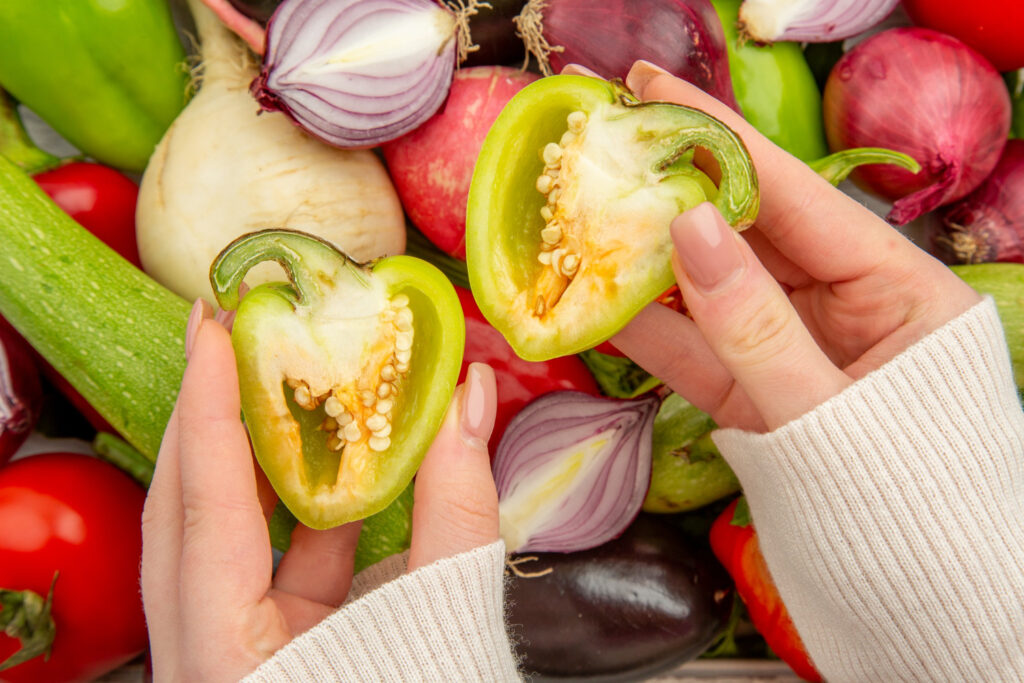
Bell peppers (Capsicum annuum L.) are vibrant vegetables from the nightshade family, with colors that change as they ripen. Green bell peppers are the least ripe, offering a mild, slightly bitter flavor, while yellow, orange, purple, and red peppers are the ripest and taste sweet and fruity.
Bell peppers can be enjoyed both raw and cooked, making them a versatile and nutritious addition to a well-balanced diet. Packed with vitamins, minerals, and antioxidants, they offer numerous health benefits.
Supports Eye Health
Bell peppers are rich sources of lutein and zeaxanthin, carotenoids that are crucial for eye health. These carotenoids are the main components of the eye’s macular pigments, essential for maintaining good vision. Research indicates that daily lutein supplements can increase macular pigment optical density and improve visual function in patients with early signs of age-related macular degeneration. Additionally, higher intakes of lutein and zeaxanthin have been linked to a reduced risk of advanced age-related macular degeneration. Thus, a diet rich in these carotenoids, like bell peppers, can help prevent this condition.
Helps Prevent Anemia
Anemia, characterized by insufficient hemoglobin, can lead to fatigue, impaired immunity, and cognitive function issues. The World Health Organization (WHO) estimates that half of the 1.62 billion cases of anemia worldwide are due to iron deficiency. Bell peppers contain iron and are high in vitamin C, which enhances the absorption of plant-based iron. One large red pepper provides about 0.705 milligrams of iron and 210 milligrams of vitamin C, making it a great food for preventing iron deficiency anemia. This combination is particularly beneficial for those at risk, such as young children, women of reproductive age, and pregnant women.
Provides Antioxidant Support
Bell peppers are rich in antioxidants, including vitamins A and C, beta carotene, and phenolic compounds, which help protect the body against oxidative cell damage. These antioxidants may help prevent inflammatory conditions like certain cancers, cardiovascular diseases, and neurological disorders. Yellow peppers, in particular, have the highest antioxidant activity, but all bell pepper colors are excellent for fighting free radicals and reducing oxidative stress.
Arthritis Relief
Bell peppers contain vitamin C and beta-cryptoxanthin, which have anti-inflammatory properties. They are also rich in antioxidants like quercetin and luteolin. These nutrients can help reduce inflammation associated with arthritis, easing symptoms and chronic discomfort. Including bell peppers in a balanced diet can support efforts to manage arthritis symptoms effectively.
Nutritional Facts of Bell Peppers

Bell peppers are low in calories and high in nutrients. Most of their calories come from carbohydrates, but they also contain small amounts of protein and fat. Despite their high water content, they are packed with powerful nutrients.
Nutritional Facts for One Large Red Bell Pepper (164 grams):
- Calories: 43
- Fat: 0.49 grams
- Carbohydrates: 9.9 grams
- Fiber: 3.4 grams
- Protein: 1.6 grams
- Iron: 0.71 milligrams (9% DV)
- Vitamin A: 257 micrograms (29% DV)
- Vitamin C: 210 milligrams (233% DV)
- Vitamin E: 2.59 milligrams (17% DV)
- Potassium: 346 milligrams (10% DV)
- Folate: 75.4 micrograms (19% DV)
Nutritional Facts for One Large Green Bell Pepper (164 grams):
- Calories: 38
- Fat: 0.18 grams
- Carbohydrates: 7.8 grams
- Fiber: 1.5 grams
- Protein: 1.2 grams
- Iron: 0.31 milligrams (4% DV)
- Vitamin C: 163 milligrams (181% DV)
- Potassium: 267 milligrams (8% DV)
- Folate: 36.1 micrograms (9% DV)
Risks of Eating Bell Peppers
While bell peppers are generally safe for most people, some may experience adverse effects. Rarely, individuals allergic to pollen may also be allergic to bell peppers due to cross-reactivity. Additionally, consuming large amounts may cause gas or bloating due to their high fiber content. It’s advisable to monitor portion sizes and consult a healthcare provider if you have concerns.
Tips for Consuming Bell Peppers
To maximize freshness, keep bell peppers dry and store them in an open mesh or plastic bag in a low-humidity refrigerator drawer. They can be enjoyed in various ways:
- Raw: Add to salads or eat as a snack.
- Sauteed: Sauté with low-sodium seasonings.
- Grilled: Brush with olive oil, grill until charred, then wrap in foil and let sit.
- Roasted: Cut in half, bake at 425°F until skins are wrinkled.
- Stuffed: Fill with a protein source and bake for a wholesome meal.
Bell peppers come in a variety of hues, each offering different flavors. Green peppers are bitter, while yellow, red, orange, and purple peppers are sweet, making them a delightful addition to numerous dishes.
Takeaway
Bell peppers are not only versatile and delicious but also offer a multitude of health benefits. They support eye health, help prevent anemia, provide antioxidant support, and offer relief from arthritis symptoms. With their impressive nutrient profile and various culinary uses, bell peppers are a valuable addition to any diet.











